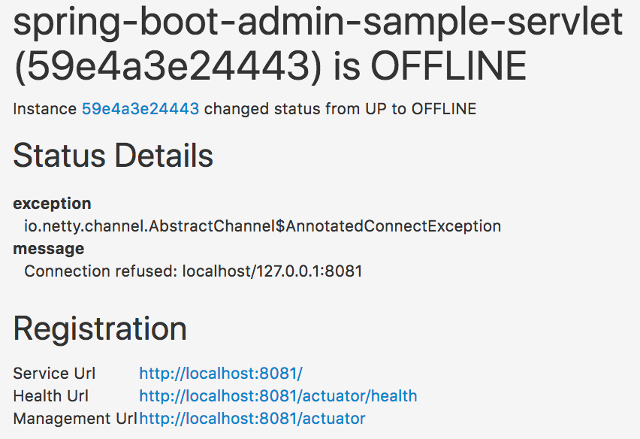2019獨角獸企業重金招聘Python工程師標準>>> 
Spring Boot Admin Reference Guide
Johannes Edmeier@joshisteVersion 2.2.0-SNAPSHOT,16.03.2019
1. What is Spring Boot Admin?
Spring boot,codecentric’s Spring Boot Admin is a community project to manage and monitor your?Spring Boot???applications. The applications register with our Spring Boot Admin Client (via HTTP) or are discovered using Spring Cloud???(e.g. Eureka, Consul). The UI is just a Vue.js application on top of the Spring Boot Actuator endpoints.
2. Getting started
2.1. Setting up Spring Boot Admin Server
First, you need to setup your server. To do this just setup a simple boot project (using?start.spring.io). As Spring Boot Admin Server is capable of running as servlet or webflux application, you need to decide on this and add the according Spring Boot Starter. In this example we’re using the servlet web starter.
-
Add Spring Boot Admin Server starter to your dependencies:
pom.xml
<dependency><groupId>de.codecentric</groupId><artifactId>spring-boot-admin-starter-server</artifactId><version>2.2.0-SNAPSHOT</version> </dependency> <dependency><groupId>org.springframework.boot</groupId><artifactId>spring-boot-starter-web</artifactId> </dependency> -
Pull in the Spring Boot Admin Server configuration via adding?
@EnableAdminServer?to your configuration:@Configuration @EnableAutoConfiguration @EnableAdminServer public class SpringBootAdminApplication {public static void main(String[] args) {SpringApplication.run(SpringBootAdminApplication.class, args);} }
| ? | If you want to setup the Spring Boot Admin Server via war-deployment in a servlet-container, please have a look at the?spring-boot-admin-sample-war. |
See also the?spring-boot-admin-sample-servlet?project, which also adds security.
2.2. Registering Client Applications
To register your application at the SBA Server, you can either include the SBA Client or use?Spring Cloud Discovery?(e.g. Eureka, Consul, …?). There is also a?simple option using a static configuration on the SBA Server side.
2.2.1. Spring Boot Admin Client
Each application that wants to register has to include the Spring Boot Admin Client. In order to secure the endpoints, also add the?spring-boot-starter-security.
-
Add spring-boot-admin-starter-client to your dependencies:
pom.xml
<dependency><groupId>de.codecentric</groupId><artifactId>spring-boot-admin-starter-client</artifactId><version>2.2.0-SNAPSHOT</version> </dependency> <dependency><groupId>org.springframework.boot</groupId><artifactId>spring-boot-starter-security</artifactId> </dependency> -
Enable the SBA Client by configuring the URL of the Spring Boot Admin Server:
application.properties
spring.boot.admin.client.url=http://localhost:8080 management.endpoints.web.exposure.include=*? The URL of the Spring Boot Admin Server to register at. ? As with Spring Boot 2 most of the endpoints aren’t exposed via http by default, we expose all of them. For production you should carefully choose which endpoints to expose. -
Make the actuator endpoints accessible:
@Configuration public static class SecurityPermitAllConfig extends WebSecurityConfigurerAdapter {@Overrideprotected void configure(HttpSecurity http) throws Exception {http.authorizeRequests().anyRequest().permitAll() .and().csrf().disable();} }? For the sake of brevity we’re disabling the security for now. Have a look at the?security section?on how to deal with secured endpoints.
2.2.2. Spring Cloud Discovery
If you already use Spring Cloud Discovery for your applications you don’t need the SBA Client. Just add a DiscoveryClient to Spring Boot Admin Server, the rest is done by our AutoConfiguration.
The following steps uses Eureka, but other Spring Cloud Discovery implementations are supported as well. There are examples using?Consul?and?Zookeeper.
Also, have a look at the?Spring Cloud documentation.
-
Add spring-cloud-starter-eureka to your dependencies:
pom.xml
<dependency><groupId>org.springframework.cloud</groupId><artifactId>spring-cloud-starter-netflix-eureka-client</artifactId> </dependency> -
Enable discovery by adding?
@EnableDiscoveryClient?to your configuration:@Configuration @EnableAutoConfiguration @EnableDiscoveryClient @EnableAdminServer public class SpringBootAdminApplication {public static void main(String[] args) {SpringApplication.run(SpringBootAdminApplication.class, args);}@Configurationpublic static class SecurityPermitAllConfig extends WebSecurityConfigurerAdapter {@Overrideprotected void configure(HttpSecurity http) throws Exception {http.authorizeRequests().anyRequest().permitAll() .and().csrf().disable();}} }? For the sake of brevity we’re disabling the security for now. Have a look at the?security section?on how to deal with secured endpoints. -
Tell the Eureka client where to find the service registry:
application.yml
eureka: instance:leaseRenewalIntervalInSeconds: 10health-check-url-path: /actuator/healthmetadata-map:startup: ${random.int} #needed to trigger info and endpoint update after restartclient:registryFetchIntervalSeconds: 5serviceUrl:defaultZone: ${EUREKA_SERVICE_URL:http://localhost:8761}/eureka/management:endpoints:web:exposure:include: "*" endpoint:health:show-details: ALWAYS? Configuration section for the Eureka client ? As with Spring Boot 2 most of the endpoints aren’t exposed via http by default, we expose all of them. For production you should carefully choose which endpoints to expose.
See also?spring-boot-admin-sample-eureka.
| ? | You can include the Spring Boot Admin Server to your Eureka server. Setup everything as described above and set?spring.boot.admin.context-path?to something different than?"/"?so that the Spring Boot Admin Server UI won’t clash with Eureka’s one. |
3. Client Applications
3.1. Show Version in Application List
For?Spring Boot?applications the easiest way to show the version, is to use the?build-info?goal from the?spring-boot-maven-plugin, which generates the?META-INF/build-info.properties. See also the?Spring Boot Reference Guide.
For?non-Spring Boot?applications you can either add a?version?or?build.version?to the registration metadata and the version will show up in the application list.
pom.xml
<build><plugins><plugin><groupId>org.springframework.boot</groupId><artifactId>spring-boot-maven-plugin</artifactId><executions><execution><goals><goal>build-info</goal></goals></execution></executions></plugin></plugins>
</build>3.2. JMX-Bean Management
To interact with JMX-beans in the admin UI you have to include?Jolokia?in your application. As Jolokia is servlet based there is no support for reactive applications. In case you are using the?spring-boot-admin-starter-client?it will be pulled in for you, if not add Jolokia to your dependencies:
pom.xml
<dependency><groupId>org.jolokia</groupId><artifactId>jolokia-core</artifactId>
</dependency>3.3. Logfile Viewer
By default the logfile is not accessible via actuator endpoints and therefore not visible in Spring Boot Admin. In order to enable the logfile actuator endpoint you need to configure Spring Boot to write a logfile, either by setting?logging.pathor?logging.file.
Spring Boot Admin will detect everything that looks like an URL and render it as hyperlink.
ANSI color-escapes are also supported. You need to set a custom file log pattern as Spring Boot’s default one doesn’t use colors.
application.properties
logging.file=/var/log/sample-boot-application.log
logging.pattern.file=%clr(%d{yyyy-MM-dd HH:mm:ss.SSS}){faint} %clr(%5p) %clr(${PID}){magenta} %clr(---){faint} %clr([%15.15t]){faint} %clr(%-40.40logger{39}){cyan} %clr(:){faint} %m%n%wEx | ? | Destination the logfile is written to. Enables the logfile actuator endpoint. |
| ? | File log pattern using ANSI colors. |
3.4. Show Tags per Instance
Tags?are a way to add visual markers per instanace, they will appear in the application list as well as in the instance view. By default no tags are added to instances, and it’s up to the client to specify the desired tags by adding the information to the metadata or info endpoint.
application.properties
#using the metadata spring.boot.admin.client.instance.metadata.tags.environment=test#using the info endpoint info.tags.environment=test
3.5. Spring Boot Admin Client
The Spring Boot Admin Client registers the application at the admin server. This is done by periodically doing a HTTP post request to the SBA Server providing information about the application. It also adds Jolokia to your application, so that JMX-beans are accessible via HTTP.
| ? | There are plenty of properties to influence the way how the SBA Client registers your application. In case that doesn’t fit your needs, you can provide your own?AppliationFactory?implementation. |
| Property name | Description | Default value |
|---|---|---|
| spring.boot.admin.client.enabled | Enables the Spring Boot Admin Client. |
|
| spring.boot.admin.client.url | Comma separated ordered list of URLs of the Spring Boot Admin server to register at. This triggers the AutoConfiguration.?Mandatory. | ? |
| spring.boot.admin.client.api-path | Http-path of registration endpoint at your admin server. |
|
| spring.boot.admin.client.username | Username and password in case the SBA Server api is protected with HTTP Basic authentication. | ? |
| spring.boot.admin.client.period | Interval for repeating the registration (in ms). |
|
| spring.boot.admin.client.connect-timeout | Connect timeout for the registration (in ms). |
|
| spring.boot.admin.client.read-timeout | Read timeout for the registration (in ms). |
|
| spring.boot.admin.client.auto-registration | If set to true the periodic task to register the application is automatically scheduled after the application is ready. |
|
| spring.boot.admin.client.auto-deregistration | Switch to enable auto-deregistration at Spring Boot Admin server when context is closed. If the value is unset the feature is active if a running CloudPlatform was detected. |
|
| spring.boot.admin.client.register-once | If set to true the client will only register against one admin server (in order defined by? |
|
| spring.boot.admin.client.instance.health-url | Health-url to register with. Can be overridden in case the reachable URL is different (e.g. Docker). Must be unique in registry. | Guessed based on management-url and? |
| spring.boot.admin.client.instance.management-base-url | Base url for computing the management-url to register with. The path is inferred at runtime, and appended to the base url. | Guessed based on? |
| spring.boot.admin.client.instance.management-url | Management-url to register with. Can be overridden in case the reachable url is different (e.g. Docker). | Guessed based on management-base-url and? |
| spring.boot.admin.client.instance.service-base-url | Base url for computing the service-url to register with. The path is inferred at runtime, and appended to the base url. | Guessed based on hostname,? |
| spring.boot.admin.client.instance.service-url | Service-url to register with. Can be overridden in case the reachable url is different (e.g. Docker). | Guessed based on service-base-url and? |
| spring.boot.admin.client.instance.name | Name to register with. |
|
| spring.boot.admin.client.instance.prefer-ip | Use the ip-address rather then the hostname in the guessed urls. If? |
|
| spring.boot.admin.client.instance.metadata.* | Metadata key-value-pairs to be associated with this instance. | ? |
| spring.boot.admin.client.instance.metadata.tags.* | Tags as key-value-pairs to be associated with this instance. | ? |
| Key | Value | Default value |
|---|---|---|
| user.name | Credentials being used to access the endpoints. | ? |
4. Spring Boot Admin Server
4.1. Running Behind a Front-end Proxy Server
In case the Spring Boot Admin server is running behind a reverse proxy, it may be requried to configure the public url where the server is reachable via (spring.boot.admin.ui.public-url). In addition when the reverse proxy terminates the https connection, it may be necessary to configure?server.use-forward-headers=true?(also see?Spring Boot Reference Guide).
4.2. Configuration Options
| Property name | Description | Default value |
|---|---|---|
| spring.boot.admin.context-path | The context-path prefixes the path where the Admin Server’s statics assets and API should be served. Relative to the Dispatcher-Servlet. | ? |
| spring.boot.admin.monitor.status-interval | Time interval to check the status of instances. | 10,000ms |
| spring.boot.admin.monitor.status-lifetime | Lifetime of status. The status won’t be updated as long the last status isn’t expired. | 10,000ms |
| spring.boot.admin.monitor.info-interval | Time interval to check the info of instances. | 1m |
| spring.boot.admin.monitor.info-lifetime | Lifetime of info. The info won’t be updated as long the last info isn’t expired. | 1m |
| spring.boot.admin.monitor.default-timeout | Default timeout when making requests. Individual values for specific endpoints can be overriden using? | 10,000 |
| spring.boot.admin.monitor.timeout.* | Key-Value-Pairs with the timeout per endpointId. Defaults to default-timeout. | ? |
| spring.boot.admin.monitor.default-retries | Default number of retries for failed requests. Modyfing requests ( | 0 |
| spring.boot.admin.monitor.retries.* | Key-Value-Pairs with the number of retries per endpointId. Defaults to default-retries. Modyfing requests ( | ? |
| spring.boot.admin.metadata-keys-to-sanitize | Metadata values for the keys matching these regex patterns will be sanitized in all json output. |
|
| spring.boot.admin.probed-endpoints | For Spring Boot 1.x client applications SBA probes for the specified endpoints using an OPTIONS request. If the path differs from the id you can specify this as id:path (e.g. health:ping).. |
|
| spring.boot.admin.instance-proxy.ignored-headers | Headers not to be forwarded when making requests to clients. | `"Cookie", "Set-Cookie", "Authorization" |
| spring.boot.admin.ui.public-url | Base url to use to build the base href in the ui. | If running behind a reverse proxy (using path rewriting) this can be used to make correct self references. If the host/port is omitted it will be inferred from the request. |
| spring.boot.admin.ui.brand | Brand to be shown in the navbar. |
|
| spring.boot.admin.ui.title | Page-Title to be shown. |
|
| spring.boot.admin.ui.favicon | Icon used as default favicon and icon for desktop notifications. |
|
| spring.boot.admin.ui.favicon-danger | Icon used as favicon when one or more service is down and for desktop notifications. |
|
4.3. Spring Cloud Discovery
The Spring Boot Admin Server can use Spring Clouds?DiscoveryClient?to discover applications. The advantage is that the clients don’t have to include the?spring-boot-admin-starter-client. You just have to add a?DiscoveryClientimplementation to your admin server - everything else is done by AutoConfiguration.
4.3.1. Static Configuration using SimpleDiscoveryClient
Spring Cloud provides a?SimpleDiscoveryClient. It allows you to specify client applications via static configuration:
pom.xml
<dependency><groupId>org.springframework.cloud</groupId><artifactId>spring-cloud-starter</artifactId>
</dependency>application.yml
spring:cloud:discovery:client:simple:instances:test:- uri: http://instance1.intern:8080metadata:management.context-path: /actuator- uri: http://instance2.intern:8080metadata:management.context-path: /actuator4.3.2. Other DiscoveryClients
Spring Boot Admin supports all other implementations of Spring Cloud’s?DiscoveryClient?(Eureka, Zookeeper, Consul, …?). You need to add it to the Spring Boot Admin Server and configure it properly. An?example setup using Eureka?is shown above.
4.3.3. Converting ServiceInstances
The information from the service registry are converted by the?ServiceInstanceConverter. Spring Boot Admin ships with a default and Eureka converter implementation. The correct one is selected by AutoConfiguration.
| ? | You can modify how the information from the registry is used to register the application by using SBA Server configuration options and instance metadata. The values from the metadata takes precedence over the server config. If the plenty of options don’t fit your needs you can provide your own?ServiceInstanceConverter. |
| ? | When using Eureka, the?healthCheckUrl?known to Eureka is used for health-checking, which can be set on your client using?eureka.instance.healthCheckUrl. |
| Key | Value | Default value |
|---|---|---|
| user.name | Credentials being used to access the endpoints. | ? |
| management.address | The address is substituted in the service URL and will be used for accessing the actuator endpoints. | ? |
| management.port | The port is substituted in the service URL and will be used for accessing the actuator endpoints. | ? |
| management.context-path | The path is appended to the service URL and will be used for accessing the actuator endpoints. |
|
| health.path | The path is appended to the service URL and will be used for the health-checking. Ignored by the? |
|
| Property name | Description | Default value |
|---|---|---|
| spring.boot.admin.discovery.enabled | Enables the DiscoveryClient-support for the admin server. |
|
| spring.boot.admin.discovery.converter.management-context-path | Will be appended to the service-url of the discovered service when the management-url is converted by the? |
|
| spring.boot.admin.discovery.converter.health-endpoint-path | Will be appended to the management-url of the discovered service when the health-url is converted by the? |
|
| spring.boot.admin.discovery.ignored-services | This services will be ignored when using discovery and not registered as application. Supports simple patterns (e.g. "foo*", "*bar", "foo*bar*"). | ? |
| spring.boot.admin.discovery.services | This services will be included when using discovery and registered as application. Supports simple patterns (e.g. "foo*", "*bar", "foo*bar*"). |
|
4.3.4. CloudFoundry
If you are deploying your applications to CloudFoundry then?vcap.application.application_id?and?vcap.application.instance_index?must?be added to the metadata for proper registration of applications with Spring Boot Admin Server. Here is a sample configuration for Eureka:
application.yml
eureka:instance:hostname: ${vcap.application.uris[0]}nonSecurePort: 80metadata-map:applicationId: ${vcap.application.application_id}instanceId: ${vcap.application.instance_index}4.4. Clustering
Spring Boot Admin Server supports cluster replication via Hazelcast. It is automatically enabled when a?HazelcastConfig- or?HazelcastInstance-Bean is present. You can also configure the Hazelcast instance to be persistent, to keep the status over restarts. Also have a look at the?Spring Boot support for Hazelcast.
-
Add Hazelcast to your dependencies:
pom.xml
<dependency><groupId>com.hazelcast</groupId><artifactId>hazelcast</artifactId> </dependency> -
Instantiate a HazelcastConfig:
@Bean public Config hazelcastConfig() {MapConfig mapConfig = new MapConfig("spring-boot-admin-event-store").setInMemoryFormat(InMemoryFormat.OBJECT).setBackupCount(1).setEvictionPolicy(EvictionPolicy.NONE).setMergePolicyConfig(new MergePolicyConfig(PutIfAbsentMapMergePolicy.class.getName(),100));return new Config().setProperty("hazelcast.jmx", "true").addMapConfig(mapConfig); }
| Property name | Description | Default value |
|---|---|---|
| spring.boot.admin.hazelcast.enabled | Enables the Hazelcast support |
|
| spring.boot.admin.hazelcast.event-store | Name of the Hazelcast-map to store the events |
|
4.5. Notifications
4.5.1. Reminder Notifications
The?RemindingNotifier?sends reminders for down/offline applications, it delegates the sending of notifications to another notifier.
By default a reminder is triggered when a registered application changes to?DOWN?or?OFFLINE. You can alter this behaviour via?setReminderStatuses(). The reminder ends when either the status changes to a non-triggering status or the regarding application gets deregistered.
By default the reminders are sent every 10 minutes, to change this use?setReminderPeriod(). The?RemindingNotifieritself doesn’t start the background thread to send the reminders, you need to take care of this as shown in the given example below;
How to configure reminders
@Configuration
public class NotifierConfiguration {@Autowiredprivate Notifier notifier;@Primary@Bean(initMethod = "start", destroyMethod = "stop")public RemindingNotifier remindingNotifier() {RemindingNotifier notifier = new RemindingNotifier(notifier, repository);notifier.setReminderPeriod(Duration.ofMinutes(10)); notifier.setCheckReminderInverval(Duration.ofSeconds(10)); return notifier;}
}| ? | The reminders will be sent every 10 minutes. |
| ? | Schedules sending of due reminders every 10 seconds. |
4.5.2. Filtering Notifications
The?FilteringNotifier?allows you to filter certain notification based on rules you can add/remove at runtime. It delegates the sending of notifications to another notifier.
If you add a?FilteringNotifier?to your?ApplicationContext?a RESTful interface on?notifications/filter?gets available.
This notifier is useful if you don’t want recieve notifications when deploying your applications. Before stopping the application you can add an (expiring) filter either via a?POST?request.
How to configure filtering
@Configuration
public static class NotifierConfig {private final InstanceRepository repository;private final ObjectProvider<List<Notifier>> otherNotifiers;public NotifierConfig(InstanceRepository repository, ObjectProvider<List<Notifier>> otherNotifiers) {this.repository = repository;this.otherNotifiers = otherNotifiers;}@Beanpublic FilteringNotifier filteringNotifier() { CompositeNotifier delegate = new CompositeNotifier(otherNotifiers.getIfAvailable(Collections::emptyList));return new FilteringNotifier(delegate, repository);}@Primary@Bean(initMethod = "start", destroyMethod = "stop")public RemindingNotifier remindingNotifier() { RemindingNotifier notifier = new RemindingNotifier(filteringNotifier(), repository);notifier.setReminderPeriod(Duration.ofMinutes(10));notifier.setCheckReminderInverval(Duration.ofSeconds(10));return notifier;}
}| ? | Add the?FilteringNotifier?bean using a delegate (e.g.?MailNotifier?when configured) |
| ? | Add the?RemindingNotifier?as primary bean using the?FilteringNotifier?as delegate. |
| ? | This example combines the reminding and filtering notifiers. This allows you to get notifications after the deployed application hasn’t restarted in a certain amount of time (until the filter expires). |
4.5.3. Mail Notifications
Mail notifications will be delivered as HTML emails rendered using?Thymeleaf?templates. To enable Mail notifications, configure a?JavaMailSender?using?spring-boot-starter-mail?and set a recipient.

Figure 1. Sample Mail Notification
| ? | To prevent disclosure of sensitive information, the default mail template doesn’t show any metadata of the instance. If you want to you show some of the metadata you can use a custom template. |
-
Add spring-boot-starter-mail to your dependencies:
pom.xml
<dependency><groupId>org.springframework.boot</groupId><artifactId>spring-boot-starter-mail</artifactId> </dependency> -
Configure a JavaMailSender
application.properties
spring.mail.host=smtp.example.com spring.boot.admin.notify.mail.to=admin@example.com
-
Configure the mail with the options below
Property name Description Default value spring.boot.admin.notify.mail.enabled
Enable mail notifications
truespring.boot.admin.notify.mail.ignore-changes
Comma-delimited list of status changes to be ignored. Format: "<from-status>:<to-status>". Wildcards allowed.
"UNKNOWN:UP"spring.boot.admin.notify.mail.template
Resource path to the Thymelef template used for rendering.
"classpath:/META-INF/spring-boot-admin-server/mail/status-changed.html"spring.boot.admin.notify.mail.to
Comma-delimited list of mail recipients
"root@localhost"spring.boot.admin.notify.mail.cc
Comma-delimited list of carbon-copy recipients
? spring.boot.admin.notify.mail.from
Mail sender
"Spring Boot Admin <noreply@localhost>"spring.boot.admin.notify.mail.additional-properties
Additional properties which can be accessed from the template
?
4.5.4. PagerDuty Notifications
To enable?PagerDuty?notifications you just have to add a generic service to your PagerDuty-account and set?spring.boot.admin.notify.pagerduty.service-key?to the service-key you received.
| Property name | Description | Default value |
|---|---|---|
| spring.boot.admin.notify.pagerduty.enabled | Enable mail notifications |
|
| spring.boot.admin.notify.pagerduty.ignore-changes | Comma-delimited list of status changes to be ignored. Format: "<from-status>:<to-status>". Wildcards allowed. |
|
| spring.boot.admin.notify.pagerduty.service-key | Service-key to use for PagerDuty | ? |
| spring.boot.admin.notify.pagerduty.url | The Pagerduty-rest-api url |
|
| spring.boot.admin.notify.pagerduty.description | Description to use in the event. SpEL-expressions are supported |
|
| spring.boot.admin.notify.pagerduty.client | Client-name to use in the event | ? |
| spring.boot.admin.notify.pagerduty.client-url | Client-url to use in the event | ? |
4.5.5. OpsGenie Notifications
To enable?OpsGenie?notifications you just have to add a new JSON Rest API integration to your OpsGenie account and set?spring.boot.admin.notify.opsgenie.api-key?to the apiKey you received.
| Property name | Description | Default value |
|---|---|---|
| spring.boot.admin.notify.opsgenie.enabled | Enable OpsGenie notifications |
|
| spring.boot.admin.notify.opsgenie.ignore-changes | Comma-delimited list of status changes to be ignored. Format: "<from-status>:<to-status>". Wildcards allowed. |
|
| spring.boot.admin.notify.opsgenie.api-key | apiKey you received when creating the integration | ? |
| spring.boot.admin.notify.opsgenie.url | OpsGenie Alert API url |
|
| spring.boot.admin.notify.opsgenie.description | Description to use in the event. SpEL-expressions are supported |
|
| spring.boot.admin.notify.opsgenie.actions | Comma separated list of actions that can be executed. | ? |
| spring.boot.admin.notify.opsgenie.source | Field to specify source of alert. By default, it will be assigned to IP address of incoming request. | ? |
| spring.boot.admin.notify.opsgenie.tags | Comma separated list of labels attached to the alert. | ? |
| spring.boot.admin.notify.opsgenie.entity | The entity the alert is related to. | ? |
| spring.boot.admin.notify.opsgenie.user | Default owner of the execution. If user is not specified, the system becomes owner of the execution. | ? |
4.5.6. Hipchat Notifications
To enable?Hipchat?notifications you need to create an API token on your Hipchat account and set the appropriate configuration properties.
| Property name | Description | Default value |
|---|---|---|
| spring.boot.admin.notify.hipchat.enabled | Enable Hipchat notifications |
|
| spring.boot.admin.notify.hipchat.ignore-changes | Comma-delimited list of status changes to be ignored. Format: "<from-status>:<to-status>". Wildcards allowed. |
|
| spring.boot.admin.notify.hipchat.url | The HipChat REST API (V2) URL | ? |
| spring.boot.admin.notify.hipchat.auth-token | The API token with access to the notification room | ? |
| spring.boot.admin.notify.hipchat.room-id | The ID or url-encoded name of the room to send notifications to | ? |
| spring.boot.admin.notify.hipchat.notify | Whether the message should trigger a user notification |
|
| spring.boot.admin.notify.hipchat.description | Description to use in the event. SpEL-expressions are supported |
|
4.5.7. Slack Notifications
To enable?Slack?notifications you need to add a incoming Webhook under custom integrations on your Slack account and configure it appropriately.
| Property name | Description | Default value |
|---|---|---|
| spring.boot.admin.notify.slack.enabled | Enable Slack notifications |
|
| spring.boot.admin.notify.slack.ignore-changes | Comma-delimited list of status changes to be ignored. Format: "<from-status>:<to-status>". Wildcards allowed. |
|
| spring.boot.admin.notify.slack.webhook-url | The Slack Webhook URL to send notifications to. | ? |
| spring.boot.admin.notify.slack.channel | Optional channel name (without # at the beginning). If different than channel in Slack Webhooks settings | ? |
| spring.boot.admin.notify.slack.icon | Optional icon name (without surrounding colons). If different than icon in Slack Webhooks settings | ? |
| spring.boot.admin.notify.slack.username | Optional username to send notification if different than in Slack Webhooks settings |
|
| spring.boot.admin.notify.slack.message | Message to use in the event. SpEL-expressions and Slack markups are supported |
|
4.5.8. Let’s Chat Notifications
To enable?Let’s Chat?notifications you need to add the host url and add the API token and username from Let’s Chat
| Property name | Description | Default value |
|---|---|---|
| spring.boot.admin.notify.letschat.enabled | Enable let′s Chat notifications |
|
| spring.boot.admin.notify.letschat.ignore-changes | Comma-delimited list of status changes to be ignored. Format: "<from-status>:<to-status>". Wildcards allowed. |
|
| spring.boot.admin.notify.letschat.url | The let′s Chat Host URL to send notifications | ? |
| spring.boot.admin.notify.letschat.room | the room where to send the messages | ? |
| spring.boot.admin.notify.letschat.token | the token to access the let′s Chat API | ? |
| spring.boot.admin.notify.letschat.username | The username for which the token was created |
|
| spring.boot.admin.notify.letschat.message | Message to use in the event. SpEL-expressions are supported |
|
4.5.9. Microsoft Teams Notifications
To enable Microsoft Teams notifications you need to setup a connector webhook url and set the appropriate configuration property.
| Property name | Description | Default value |
|---|---|---|
| spring.boot.admin.notify.ms-teams.enabled | Enable Microsoft Teams notifications |
|
| spring.boot.admin.notify.ms-teams.webhook-url | The Microsoft Teams webhook url to send the notifications to. | ? |
| spring.boot.admin.notify.ms-teams.* | There are several options to customize the message title and color | ? |
4.5.10. Telegram Notifications
To enable?Telegram?notifications you need to create and authorize a telegram bot and set the appropriate configuration properties for auth-token and chat-id.
| Property name | Description | Default value |
|---|---|---|
| spring.boot.admin.notify.telegram.enabled | Enable Telegram notifications |
|
| spring.boot.admin.notify.telegram.auth-token | The token identifiying und authorizing your Telegram bot (e.g.? | ? |
| spring.boot.admin.notify.telegram.chat-id | Unique identifier for the target chat or username of the target channel | ? |
| spring.boot.admin.notify.telegram.disable-notify | If true users will receive a notification with no sound. |
|
| spring.boot.admin.notify.telegram.parse_mode | The parsing mode for the sent message. Currently? |
|
| spring.boot.admin.notify.telegram.message | Text to send. SpEL-expressions are supported. |
|
4.5.11. Discord Notifications
To enable Discord notifications you need to create a webhook and set the appropriate configuration property.
| Property name | Description | Default value |
|---|---|---|
| spring.boot.admin.notify.discord.enabled | Enable Discord notifications |
|
| spring.boot.admin.notify.discord.webhook-url | The Discord webhook url to send the notifications to. | ? |
| spring.boot.admin.notify.discord.username | Optional username. | Default set in Discord |
| spring.boot.admin.notify.discord.avatar-url | Optional URL to avatar. | Default set in Discord |
| spring.boot.admin.notify.discord.tts | If the message is a text to speech message. |
|
| spring.boot.admin.notify.discord.message | Text to send. SpEL-expressions are supported. |
|
5. Security
5.1. Securing Spring Boot Admin Server
Since there are several approaches on solving authentication and authorization in distributed web applications Spring Boot Admin doesn’t ship a default one. By default?spring-boot-admin-server-ui?provides a login page and a logout button.
A Spring Security configuration for your server could look like this:
@Configuration
public static class SecuritySecureConfig extends WebSecurityConfigurerAdapter {private final String adminContextPath;public SecuritySecureConfig(AdminServerProperties adminServerProperties) {this.adminContextPath = adminServerProperties.getContextPath();}@Overrideprotected void configure(HttpSecurity http) throws Exception {// @formatter:offSavedRequestAwareAuthenticationSuccessHandler successHandler = new SavedRequestAwareAuthenticationSuccessHandler();successHandler.setTargetUrlParameter("redirectTo");successHandler.setDefaultTargetUrl(adminContextPath + "/");http.authorizeRequests().antMatchers(adminContextPath + "/assets/**").permitAll() .antMatchers(adminContextPath + "/login").permitAll().anyRequest().authenticated() .and().formLogin().loginPage(adminContextPath + "/login").successHandler(successHandler).and() .logout().logoutUrl(adminContextPath + "/logout").and().httpBasic().and() .csrf().csrfTokenRepository(CookieCsrfTokenRepository.withHttpOnlyFalse()) .ignoringAntMatchers(adminContextPath + "/instances", adminContextPath + "/actuator/**" );// @formatter:on}
}| ? | Grants public access to all static assets and the login page. |
| ? | Every other request must be authenticated. |
| ? | Configures login and logout. |
| ? | Enables HTTP-Basic support. This is needed for the Spring Boot Admin Client to register. |
| ? | Enables CSRF-Protection using Cookies |
| ? | Disables CRSF-Protection the endpoint the Spring Boot Admin Client uses to register. |
| ? | Disables CRSF-Protection for the actuator endpoints. |
In case you use the Spring Boot Admin Client, it needs the credentials for accessing the server:
application.yml
spring.boot.admin.client:username: sba-clientpassword: s3cretFor a complete sample look at?spring-boot-admin-sample-servlet.
| ? | If you protect the?/instances?endpoint don’t forget to configure the username and password on your SBA-Client using?spring.boot.admin.client.username?and?spring.boot.admin.client.password. |
5.2. Securing Client Actuator Endpoints
When the actuator endpoints are secured using HTTP Basic authentication the SBA Server needs credentials to access them. You can submit the credentials in the metadata when registering the application. The?BasicAuthHttpHeaderProvider?then uses this metadata to add the?Authorization?header to access your application’s actuator endpoints. You can provide your own?HttpHeadersProvider?to alter the behaviour (e.g. add some decryption) or add extra headers.
Submitting the credentials using SBA Client:
application.yml
spring.boot.admin.client:url: http://localhost:8080instance:metadata:user.name: ${spring.security.user.name}user.password: ${spring.security.user.password}Submitting the credentials using Eureka:
application.yml
eureka:instance:metadata-map:user.name: ${spring.security.user.name}user.password: ${spring.security.user.password}| ? | The SBA Server masks certain metadata in the HTTP interface to prevent leaking of sensitive information. |
| ? | You should configure HTTPS for your SBA Server or (service registry) when submitting credentials via the metadata. |
| ? | When using Spring Cloud Discovery, you must be aware that anybody who can query your service registry can obtain the credentials. |
| ? | When using this approach the SBA Server decides whether or not the user can access the registered applications. There are more complex solutions possible (using OAuth2) to let the clients decide if the user can access the endpoints. For that please have a look at the samples in?joshiste/spring-boot-admin-samples. |
5.2.1. CSRF on Actuator Endpoints
Some of the actuator endpoints (e.g.?/loggers) support POST requests. When using Spring Security you need to ignore the actuator endpoints for CSRF-Protection as the Spring Boot Admin Server currently lacks support.
@Override
protected void configure(HttpSecurity http) throws Exception {http.csrf().ignoringAntMatchers("/actuator/**");
}5.3. Using Mutual TLS
SBA Server can also use client certificates to authenticate when accessing the actuator endpoints. If a custom configured?ClientHttpConnector?bean is present, Spring Boot will automatically configure a?WebClient.Builder?using it, which will be used by Spring Boot Admin.
@Bean
public ClientHttpConnector customHttpClient() {SslContextBuilder sslContext = SslContextBuilder.forClient();//Your sslContext customizations go hereHttpClient httpClient = HttpClient.create().secure(ssl -> ssl.sslContext(sslContext));return new ReactorClientHttpConnector(httpClient);
}6. Customizing
6.1. Custom Notifiers
You can add your own Notifiers by adding Spring Beans which implement the?Notifier?interface, at best by extendingAbstractEventNotifier?or?AbstractStatusChangeNotifier
public class CustomNotifier extends AbstractEventNotifier {private static final Logger LOGGER = LoggerFactory.getLogger(LoggingNotifier.class);public CustomNotifier(InstanceRepository repository) {super(repository);}@Overrideprotected Mono<Void> doNotify(InstanceEvent event, Instance instance) {return Mono.fromRunnable(() -> {if (event instanceof InstanceStatusChangedEvent) {LOGGER.info("Instance {} ({}) is {}", instance.getRegistration().getName(), event.getInstance(),((InstanceStatusChangedEvent) event).getStatusInfo().getStatus());} else {LOGGER.info("Instance {} ({}) {}", instance.getRegistration().getName(), event.getInstance(),event.getType());}});}
}6.2. Injecting Custom HTTP Headers
In case you need to inject custom HTTP headers into the requests made to the monitored application’s actuator endpoints you can easily add a?HttpHeadersProvider:
@Bean
public HttpHeadersProvider customHttpHeadersProvider() {return instance -> {HttpHeaders httpHeaders = new HttpHeaders();httpHeaders.add("X-CUSTOM", "My Custom Value");return httpHeaders;};
}6.3. Intercepting Requests And Responses
You can intercept and modify requests and responses made to the monitored application’s actuator endpoints by implementing the?InstanceExchangeFilterFunction?interface. This can be useful for auditing or adding some extra security checks.
@Bean
public InstanceExchangeFilterFunction auditLog() {return (instance, request, next) -> {if (HttpMethod.DELETE.equals(request.method()) || HttpMethod.POST.equals(request.method())) {log.info("{} for {} on {}", request.method(), instance.getId(), request.url());}return next.exchange(request);};
}6.4. Custom Views
It is possible to add custom views to the ui. The views must be implemented as?Vue.js?components.
The Javascript-Bundle and Css-Stlysheet must be placed on the classpath at?/META-INF/spring-boot-admin-server-ui/extensions/{name}/?so the server can pick them up. The?spring-boot-admin-sample-custom-ui?module contains a sample which has the necessary maven setup to build such a module.
The custom extension registers itself by calling?SBA.use()?and need to expose a?install()?function, which is called by the ui when setting up the routes. The?install()?function receives a parameter object referencing the?viewRegistry?and the?applicationStore?in order to register views and/or callbacks.
6.4.1. Adding a Top-Level View
Here is a simple top level view just listing all registered applications:
<template><pre v-text="stringify(applications, null, 4)"/>
</template><script>
export default {props: {applications: { type: Array,required: true}},methods: {stringify: JSON.stringify}
};
</script>| ? | If you define a?applications?prop the component will receive all registered applications. |
| ? | There are some helpful methods on the application and instances object available. Have a look at?application.js?and?instance.js |
And this is how you register the top-level view.
SBA.use({install({viewRegistry}) {viewRegistry.addView({name: 'custom', path: '/custom', component: custom, label: 'Custom', order: 1000, });}
});| ? | Name of the view and the route to the view |
| ? | Path where the view will be accessible |
| ? | The imported custom component, which will be rendered on the route. |
| ? | The label for the custom view to be shown in the top navigation bar. |
| ? | Order for the view. Views in the top navigation bar are sorted by ascending order. |
6.4.2. Visualizing a Custom Endpoint
Here is a view to show a custom endpoint:
<template><div class="custom"><p>Instance: <span v-text="instance.id" /></p><p>Output: <span v-text="text" /></p></div>
</template><script>export default {props: {instance: { type: Object,required: true}},data: () => ({text: ''}),async created() {const response = await this.instance.axios.get('actuator/custom'); this.text = response.data;}};
</script><style>.custom {font-size: 20px;width: 80%;}
</style>| ? | If you define a?instance?prop the component will receive the instance the view should be rendered for. |
| ? | Each instance has a preconfigured?axios?instance to access the endpoints with the correct path and headers. |
Registering the instance view works like for the top-level view with some additional properties:
SBA.use({install({viewRegistry}) {viewRegistry.addView({name: 'instances/custom',parent: 'instances', path: 'custom',component: customEndpoint,label: 'Custom',order: 1000,isEnabled: ({instance}) => instance.hasEndpoint('custom') });}
});| ? | The parent must be 'instances' in order to render the new custom view for a single instance. |
| ? | If you add a?isEnabled?callback you can figure out dynamically if the view should be show for the particular instance. |
6.5. Customizing Header Logo and Title
You can set custom information in the header (i.e. displaying staging information or company name) by using following configuration properties:
-
spring.boot.admin.ui.brand: This HTML snippet is rendered in navigation header and defaults to?
<img src="assets/img/icon-spring-boot-admin.svg"><span>Spring Boot Admin</span>. By default it shows the SBA logo followed by it’s name. If you want to show a custom logo you can set:?spring.boot.admin.ui.brand=<img src="custom/custom-icon.png">. Either you just add the image to your jar-file in?/META-INF/spring-boot-admin-server-ui/?(SBA registers a?ResourceHandler?for this location by default), or you must ensure yourself that the image gets served correctly (e.g. by registering your own?ResourceHandler) -
spring.boot.admin.ui.title: Use this option to customize the browsers window title.
6.6. Customizing Favicon
It is possible to use a custom favicon, which is also used for desktop notifications. Spring Boot Admin uses a different icon when one or more application is down.
-
Put the favicon (
.png?with at least 192x192 pixels) in a resource location which is served via http (e.g.?/META-INF/spring-boot-admin-server-ui/assets/img/). -
Configure the icons to use using the following properties:
-
spring.boot.admin.ui.favicon: Used as default icon. (e.g?assets/img/custom-favicon.png -
spring.boot.admin.ui.favicon-danger: Used when one or more service is down. (e.g?assets/img/custom-favicon-danger.png)
-
7. Monitoring Spring Boot 1.5.x
It is possible to monitor Spring Boot 1.5.x applications with Spring Boot Admin 2.x. The old Spring Boot Admin Client is able to register at a newer server. Since the API has slight changes, you need to set the following property on old clients:
-
Reconfigure the api path for Spring Boot Admin Client 1.5.x:
application.yml
spring.boot.admin.api-path: instances
As some of the actuator endpoints changed with the Spring Boot 2 release not all options might be available (e.g.?/metrics?endpoint); for some of the endpoints we provide legacy converters.
8. Changes with 2.x
-
Added stable automatic-module-name to all jars
8.1. UI
-
Rewritten ui using vue.js
-
Integrated ui-login module into the main ui module
-
Removed ui-activiti module, as it was only used rarely
-
Removed Hystrix-Dashboard integration (subject to change)
-
Added support for the session endpoint
-
Added display of the (sanitized) metadata
-
Added option to reset loglevels
-
Added wallboard view
8.2. Backend
-
Moved all classes to the?
spring.boot.admin.server?package -
Spring cloud related extenstions moved to?
spring-boot-admin-server-cloud. -
Redesigned backend using event sourcing principles
-
Added concept of applications (consisting of 1 to n instances)
-
Moved endpoint detection to the backend by querying the?
/actuator-index or by probing via OPTIONS request -
Replaced Zuul with a custom proxy using the WebClient
-
Removed dependency on spring-cloud-starter
-
Added?
CompositeHttpHeadersProvider?to support multiple?HttpHeadersProviders?at the same time -
Added `InstanceExchangeFilterFunction`s which allows to intercept/modify the requests to the monitored instances
-
Added out-of-the-box support for CloudFoundry
-
Added support for Spring Boot 1.5.x actuator endpoints using?
LegacyEndpointConverters -
Update?
OpsGenieNotifier?to api v2 -
Rewritten the?
MailNotifier?to use Thymeleaf templates
8.3. Client
-
Moved all properties to?
spring.boot.admin.client.?and?spring.boot.admin.client.instance. -
Moved all classes to the?
spring.boot.admin.client?package -
Added support webflux applications
-
Added out-of-the-box support for CloudFoundry
9. FAQs
Can I include spring-boot-admin into my business application?
tl;dr?You can, but you shouldn’t.
You can set?spring.boot.admin.context-path?to alter the path where the UI and REST-API is served, but depending on the complexity of your application you might get in trouble. On the other hand in my opinion it makes no sense for an application to monitor itself. In case your application goes down your monitoring tool also does.








![[转]Oracle修改监听口令](/upload/rand_pic/2-1377.jpg)




